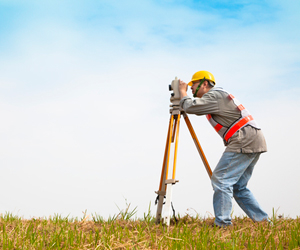National Park Service Surveying Technician Jobs
Ever wonder how modern maps with all of those nice elevation lines can be so accurate? In America’s deep past, explorers and traders were the mapmakers, essentially drawing the scenery and any memorable navigation points they came across. As you can imagine, that was a pretty subjective method, and two maps of the same land area could look very different. That’s where surveyors come in. Surveyors actually measure the entire land area they are mapping, breaking it into manageable squares, and noting down spatial data such as size, distance, shape, and elevation.

Using these data points they can create a faithful map of any land area.
In the National Forest Service, surveyors are among the first employees sent out to assess a newly acquired territory, or an old territory that has suffered a geographic change. They also work alongside architects, engineers and landscape architects, helping them to understand the “lay of the land,” and any potential strengths or weaknesses in a construction site. Without surveyors, these designers wouldn’t be able to work confidently on a job site. In the National Forest Service, surveyors also work with archeologists and historians to match geographic descriptions garnered from old maps and travel accounts to modern geographic data. This helps them to accurately pinpoint trade and travel routes, as well as historic camps and building sites.
FACT! Although George Washington is most famous for being the first U.S. President, his first career was as a land surveyor for Colonial America.
Job Descriptions
Surveyors work both indoors and outdoors, gathering spatial data in the field, and then organizing it into maps and other reports back at the office. The data gathered by the surveyors assists the work of geographers, architects, engineers, landscape architects, archeologists and historians.
- Survey Aides assist survey technicians by measuring distances, and collecting and recording data. This position is typically temporary, with appointments lasting from six months to one year.
- Survey Technicians perform a variety of surveying tasks such as collecting data using surveying instruments conducting traverse surveys, and measuring land areas.
- Lead Survey Technicians work as team leaders, facilitating team efforts in the development, implementation and evaluation of programs. They work to ensure that tasks are completed on time. To help smooth the process, they have to maintain good working relationships among team members and management officials and coordinate team priorities.
- Land Surveyors manage survey field crews in the completion of projects. In a supervisory capacity, land surveyors provide technical assistance historical research on land rights, and then guide survey methods and administrative procedures.
FACT! Besides forest lands, the National Forest Service protects more than 20 historic landmarks. They consist of national recreational areas, national scenic areas, and national monuments.
Education and Pay
Survey aid and technician positions require a high school diploma or equivalency, and varying amounts of work experience in the field. Survey aides need at least six months experience to qualify for a National Forest Service position, while technicians require a minimum of one year’s experience or two years of course work in a related field. Land surveyors must have completed a bachelor degree or higher from an accredited institution in land surveying or civil engineering with a focus on surveying, and at least two years of graduate study. Candidates may also qualify for a position as a land surveyor by holding a current land surveyor registration obtained by written examination in a state, territory, or the District of Columbia, and at least one year of experience working in the field.
Survey aids and technicians qualify for grades levels 3-5 of the General Schedule (GS) category of the Federal Wage System. Along with the higher educational levels required, land surveyors garner high wages, typically working in GS grade levels 7-9. Promotions generally occur every two to three years with the possibility of a pay raise.
Quick Summary:
- Surveyors work both indoors and outdoors, gathering spatial data in the field, then organizing it into maps and other reports.
- Survey aids and technicians require no more than a basic education consisting of a high school diploma or equivalency, and varying amounts of field experience.
- Land surveyors must have completed a bachelor degree or higher in land surveying or civil engineering with a focus on surveying, plus at least two years of graduate study.
- Survey aids and technicians qualify for grades levels 3-5 of the General Schedule (GS).
- Land surveyors typically work in GS grades 7-9.


 Teach English in Asia
Teach English in Asia  Cruise Ship Jobs
Cruise Ship Jobs  Alaska Fishing Industry Jobs
Alaska Fishing Industry Jobs  Sharing Economy / Gig Economy
Sharing Economy / Gig Economy